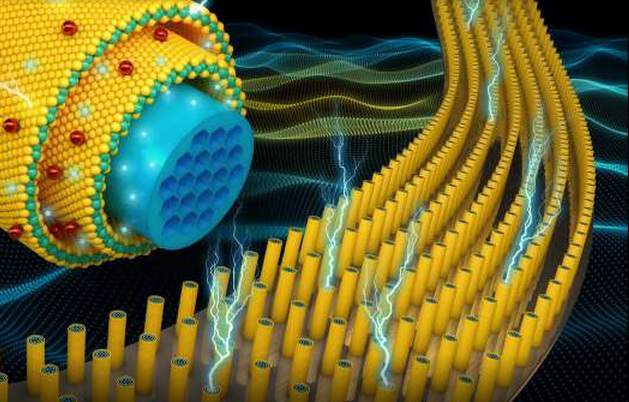导读:智能手机用户对电池续航时间和充电时间的追求是无止境的。最新的手机电池技术来自美国中佛罗里达大学,续航时间是当前锂离子电池的20倍。

Scientists from the University of Central Florida (UCF) have created a supercapacitor battery prototype that works like new even after being recharged 30,000 times. The research could yield high-capacity, ultra-fast-charging batteries that last over 20 times longer than a conventional lithium-ion cell. "You could charge your mobile phone in a few seconds and you wouldn’t need to charge it again for over a week," says UCF researcher Nitin Choudhary.
来自中佛罗里达大学(UCF)的科学家已经创造了一个超级电容电池的原型,即使充电3万次后仍然能够工作。这项研究可以得到高容量、秒充的电池,是传统的锂离子电池续航时间的20多倍。“你可以为你的手机充电几秒钟,一个多星期之内都不需要再次充电,”UCF的研究员Nitin Choudhary说。
Supercapacitors can be charged quickly because they store electricity on the surface of a material, rather than using chemical reactions. That requires "two-dimensional" material sheets that can hold lots of electrons. However, much of the research, including that by Henrik Fisker and UCLA, uses graphene as the two-dimensional material.
超级电容可以快速充电,因为它们将电存储在材料的表面上,而不是使用化学反应。这需要可以保存大量电子的“二维”材料片。然而,很多研究,包括Henrik Fisker和UCLA的研究,都使用石墨烯作为二维材料。
Yeonwoong Eric Jung from UCF says it’s a challenge to integrate graphene with other materials used in supercapacitors, though. That’s why his team wrapped 2D metal materials (TMDs) just a few atoms thick around highly-conductive 1D nanowires, letting electrons pass quickly from the core to the shell. That yielded a fast charging material with high energy and power density that’s relatively simple to produce. "We developed a simple chemical synthesis approach so we can very nicely integrate the existing materials with the two-dimensional materials," Jung says.
来自UCF的Yeonwoong Eric Jung说,将石墨烯与超级电容器中使用的其他材料集成是一个挑战。这就是为什么他的团队在高度导电的1D纳米线周围包裹了几个原子厚度的2D金属材料(TMDs),使电子快速从核心传递到壳层。这产生了具有高能量和功率密度的快速充电材料,其制造相对简单。“我们开发了一种简单的化学合成方法,因此我们可以很好地融合现有材料与二维材料,”Jung说。
The research is in early days and not ready for commercialization, but it looks promising. ""For small electronic devices, our materials are surpassing the conventional ones worldwide in terms of energy density, power density and cyclic stability," Choudhary said.
这项研究还在早期阶段,没有商业化的准备,但它看起来有希望。“对于小型的电子设备,我们的材料在能量密度、功率密度和循环稳定性方面超越了世界范围内的常规产品,”Choudhary说。
Jung calls the research "proof-of-concept," and the team is now trying to patent its new process. If commercialized, it could allow for EVs that can be charged in minutes rather than hours, smartphones that can be charged in seconds, and home energy storage solutions will drastically reduce our reliance on fossil fuels.
Jung称该研究为“概念验证”,这一团队目前正在试图为其新的工艺申请专利。如果进行商业化推广,它可以让电动车在几分钟而不是几小时内完成充电,智能手机可以秒充,家庭能源存储解决方案将大大降低我们对化石燃料的依赖。







